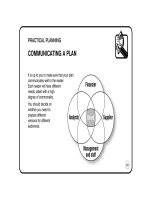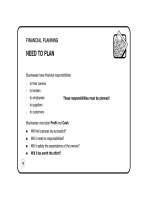Management pocketbooks the business planning pocketbook phần 3 pdf
Bạn đang xem bản rút gọn của tài liệu. Xem và tải ngay bản đầy đủ của tài liệu tại đây (332.96 KB, 11 trang )
PLANNING THEORY
WHY PLAN?
Planning will help you to:
● Shape your thoughts
● Think through scenarios and implications
● Ensure that points are not missed
● Demonstrate business control
● Identify weaknesses and opportunities
● Examine the risk of an action/set of actions against the return
● Provide a tool to communicate ideas to third parties (superiors, subordinates,
lenders, suppliers, owners, etc)
20
Low
High
Environmental
complexity
Low
High
Degree of
planning
Possible
Overkill
(navel gazing)
Success
Failure
Muddle
through
PLANNING THEORY
WHY PLAN?
Many people will say that planning
is unnecessary and that they
get by without it.
This may be fine in some
circumstances, but
where the environment
is complex it will result
in failure.
21
PLANNING THEORY
KNOW YOUR AUDIENCE
Plans are produced for several different reasons and for different people. Each
organisation has needs that are unique to it, as well as a unique set of stakeholders
(those who have an interest in the outcomes of its operations).
The major stakeholders can include some or all of:
● Shareholders
● Lenders
● Creditors
● Potential investors
● Government (tax)
● The Community, in some cases
22
PLANNING THEORY
KNOW YOUR AUDIENCE
Planner
● Sole trader
● Partnership
● Small company
● Department/unit
in an organisation
23
Audience includes:
● Bank manager, creditors, taxman, auditors
● Fellow partners, staff, bank managers, creditors,
professional body, taxman, auditors
● Directors, creditors, staff, bank manager,
taxman, auditors
● Head of department/unit, other departments/units, superiors,
auditors, group planning, accounts department
PLANNING THEORY
ELEMENTS OF A PLAN
There is no magic formula for the contents of a plan and, whilst there are some key
items that must be present, levels of details will differ with organisational needs.
Essential elements include:
● Internal situation analysis of your organisation/division/department/unit
● External analysis of your market and competition
● Product and service offerings description
● Targets going forward
● A budget for expenditure and resources
● Economic forecasts
● ‘What if?’ analysis
These elements demonstrate adequate research, analysis and thought in preparing
the plan.
24
PLANNING THEORY
PLANNING STYLES
Planning styles differ from organisation to organisation. Example styles include:
25
● Informal planning
● Numbers based (traditional)
● Scenario based
● Economic Value Analysis
● Balanced scorecard
● Top-down where the
initial plan is set centrally
● Bottom-up where
contributions are
aggregated in stages
● A blend of these two
where guidelines are set
centrally along with
macro-economic analysis,
and units are allowed to
prepare their own plans
within this framework
PLANNING THEORY
PLANNING STYLES
TOP DOWN
This type was probably the most common in organisations where formal
planning processes existed, although now many others are being used.
Plans are set centrally and cascade down the organisation. They are often
arrived at without proper consultation and discussion, setting arbitrary
targets. Those receiving the plan and its targets are, for the most part, only rarely
consulted and end up trying to achieve something that they have neither bought into nor
developed.
Not surprisingly, this type of planning is not effective, especially if the planners do not
take into account the circumstances of those executing the plans.
A theoretical set of targets might be unachievable in practice, and cause many problems
for those at the sharp end.
26
PLANNING THEORY
PLANNING STYLES
BOTTOM UP
This type of planning starts with the lowest unit that plans and then
aggregates the plans together to yield, ultimately, the final plan for the
whole organisation.
A set of guidelines is usually established (though not always), and units
produce their own plans within this framework. An aggregation process will ensure
consistency of output, reducing in detail as it flows up the organisation.
This method involves everybody and takes their input, but it can take a long time and be
very repetitive.
● Often very numbers based - strong focus on budgets
● Often leads to conflict as the units try to set themselves unduly easy targets
that do not equate with what the organisation needs
27
PLANNING THEORY
PLANNING STYLES
BLEND
This is a combination of the two preceding styles. A general plan is
constructed at the top level and then merged with the results of a bottom-
up exercise.
Usually there is a central co-ordinating body which conducts research,
gives macro-economic forecasts and sets general guidelines as well as the framework.
It acts as the aggregating and the initial challenging unit.
The results are then reviewed, challenged, altered and consolidated.
Economic capital planning often takes this approach.
28
PLANNING THEORY
PLANNING STYLES
INFORMAL PLANNING
This is usually found in smaller and medium sized organisations where, for
example, the directors meet and discuss next year’s targets and goals. It is
often found in successful entrepreneurial organisations. The key advantage
is that it is not a time-consuming exercise, and is very flexible.
Problems arise, however, when the business environment becomes more complex, and
this type of planning proves inadequate for control and measurement.
This can often have disastrous consequences for firms unless they move smoothly to
other, more disciplined, methods of planning.
29
PLANNING THEORY
PLANNING STYLES
NUMBERS BASED
Probably the most common style of all, and may be used in conjunction
with another method. It gives great comfort to people as, by concentrating
on the quantitative rather than the qualitative, it appears more certain. It is
easier to produce a cashflow than to understand the likelihood of people to
prefer your product, but you can lose sight of the bigger picture.
One of the criticisms levelled against GEC in the latter part of Arnold Weinstock’s reign
was that planning was purely based on cashflow, ignoring other aspects, and that that
led to its lack of vision.
All plans, of course, involve an element of numerical analysis, but relying wholly on
numbers has largely been discredited now and a broader perspective is more commonly
taken.
30









